In search of veracity of Krishna and Mahabharat
- In History & Culture
- 02:53 PM, Sep 25, 2022
- Nilesh Nilkanth Oak
1.0 What is Veracity
Veracity is conformity with truth or facts and conformity is correspondence in form, manner and/or character. Thus, a veracity is established via correspondence to facts where correspondence refers to agreement of things with one another.
2.0 The problem
Numerous researchers have attempted to date the specific events of Mahabharata using variety of approaches and the claims range from 7300 BCE through 400 CE. There are more than 100 different dates claimed for the year of the Mahabharata War. Many Mahabharata enthusiasts who may believe a certain claim based on their subjective judgement add to this confusion. Most folks are puzzled by this multitude of claims.
This paper discusses three key aspects about the dating of the Mahabharata war.
- Scientific, rich, and multidisciplinary evidence of the Mahabharata text
- How scientific testing of this evidence leads to unique year of 5561 BCE for the Mahabharata War.
- The reason for the emergence of multiple claims for the year of Mahabharata war.
3 Multidisciplinary evidence of the Mahabharata text
The unique, unparalleled, and fascinating aspect of Hindu civilization is that1 it constructed a language to minimize drift and to enable precision in descriptions, 2 developed ingenious system of accurate and precise timekeeping via robust astronomy and3 it made ingenious use of the first two creations to compose and preserve Itihasa. No other civilization of the world can claim any of these three assertions.
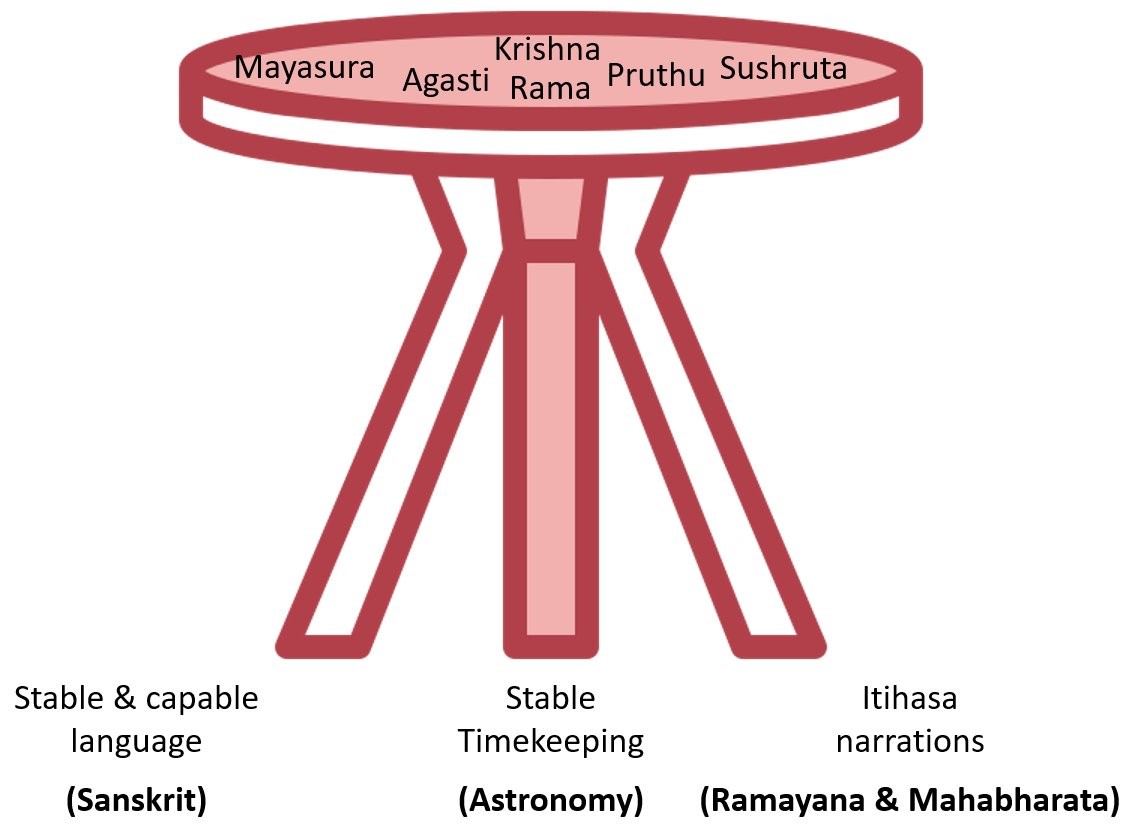
The Mahabharata text has numerous descriptions of the Mahabharata war times. These descriptions include river conditions, specific celestial and terrestrial formations, descriptions of Nimitta, analogies describing war scenes, chronological narrations, calendrical upper and lower bounds such as Lunar tithi and Lunar months, quantitative indicators such as number of warriors killed, length of the war or the duration of Bhishma on the bed of arrows, descriptions of seasons and descriptions of significant events such as flooding and destruction of Dwarka.
Science of archaeology has come a long way and has become a multidisciplinary science beyond the primitive days of ‘dirt archaeology’. Today, it combines numerous disciplines of cutting age science – Advanced mass spectrometry, Global positioning systems, sophisticated computer simulations in geology, climatology, oceanography, genetics, and astronomy.
While all descriptions of Mahahbarata text are not necessarily testable in an objective fashion, a great number of them are indeed testable in a scientific fashion and surprisingly they lead to the singular year of 5561 BCE. The evidence can be summarized visually.
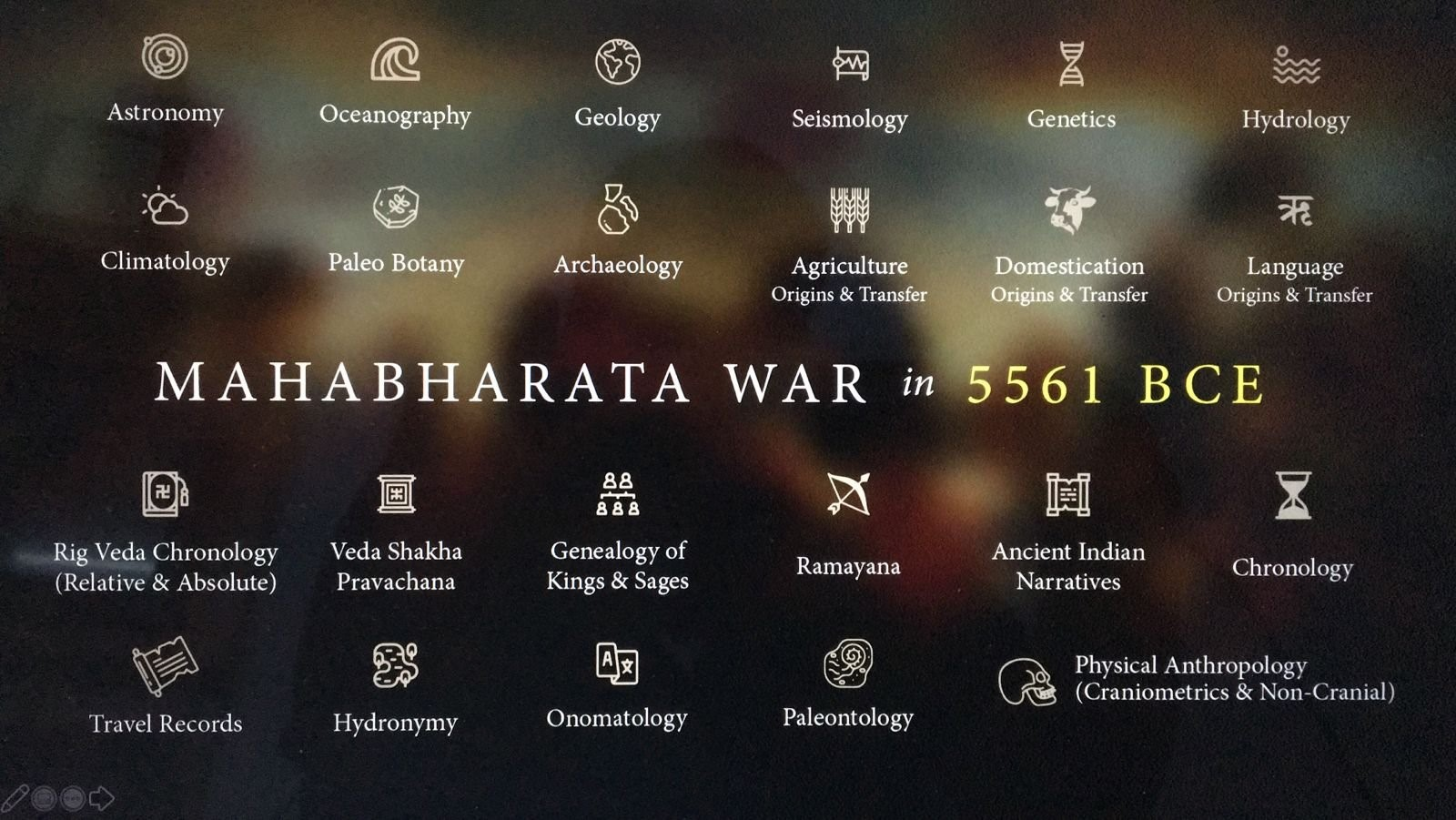
This paper discusses astronomy, oceanography and genetics evidence and demonstrates how it validates 5561 BCE as the year of the Mahabharata War.
3.1 Scientific testing of the Mahabharata evidence
A scientific study begins with unsolved problem and a revolutionary scientific study begins with one of the toughest unsolved problems. The scientific framework to solve problems can be described as a triangulation of explanation (evidence) – prediction (inference) – testing (objective validation) in the context of a theory which is proposed to solve the problem and in the context of the background knowledge.
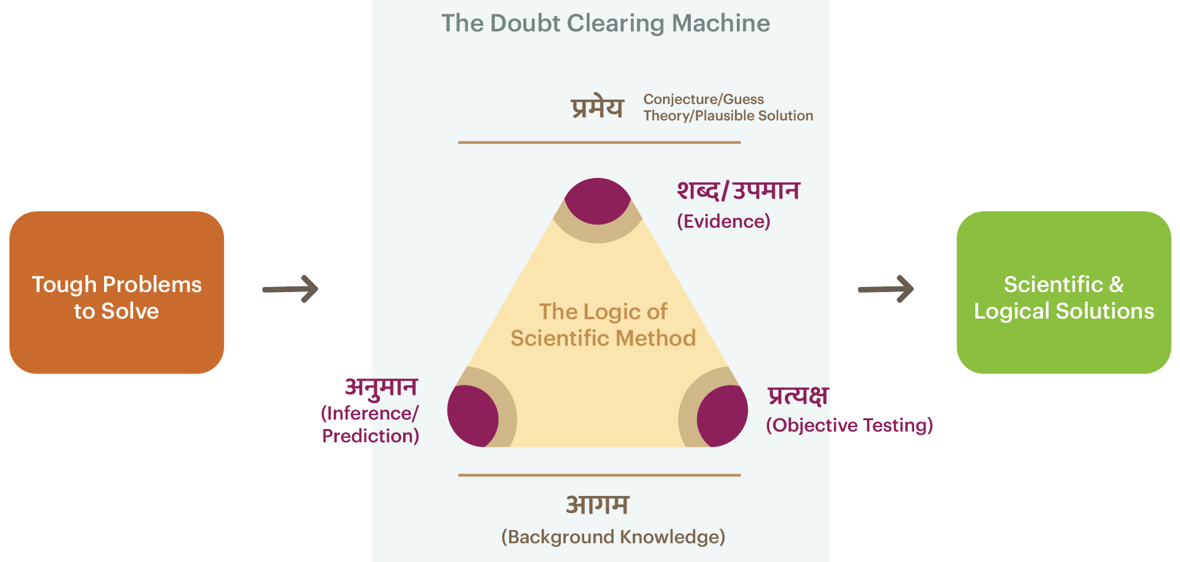
3.2.Evidence that defines the time interval of the Mahabharata War
3.2.1 Arundhati-Vashistha (AV) observation
Arundhati-Vashishtha (AV) evidence was one such toughest unsolved problem. Arundhati (Alcor) and Vashishtha (Mizar) are two stars of the Saptarshi cluster in the northern sky. Vashistha is seen walking ahead of Arundhati during their daily motion around the North pole.
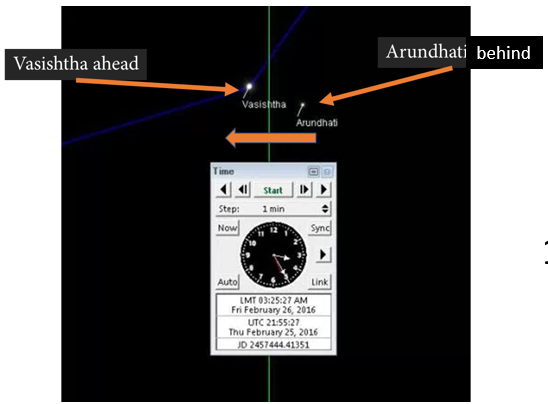
The star system is stable with very small proper motion and therefore it is shocking and surprising when the author of Mahabharata describes Arundhati walking ahead of Vashishtha at the time of the Mahabharata war. This problem unsettled the minds of greatest of the great astronomers and Mahabharata researchers alike. Likes of Bharatacharya C V Vaidya and Bharat Ratna P V Kane were forced to confess and describe this problem as “something impossible in the very order of nature.” I became aware of this problem in 1995 and was fascinated. I worked on it, industriously, for the next fifteen years, i.e., until 2009 when I successfully solved the puzzle, and the outcome was extraordinary.
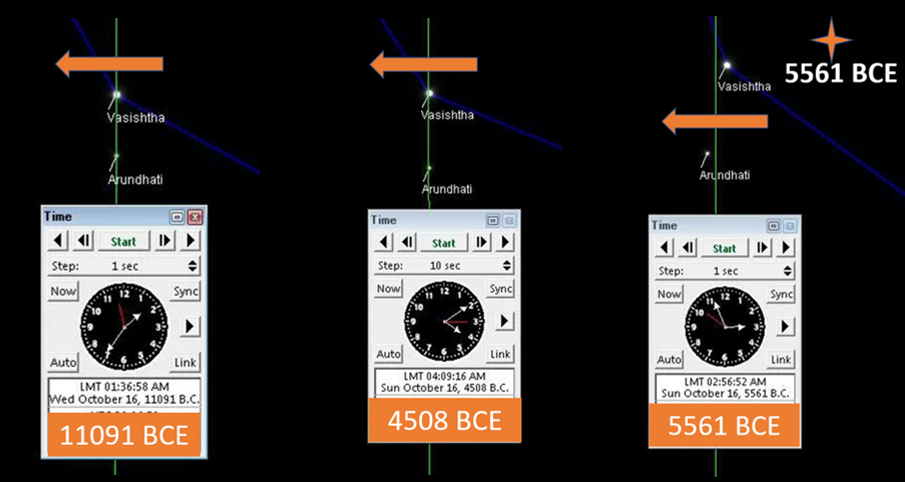
This one single evidence and its validation scientifically falsified all claims for the year of Mahabharata war that fell after 4500 BCE.
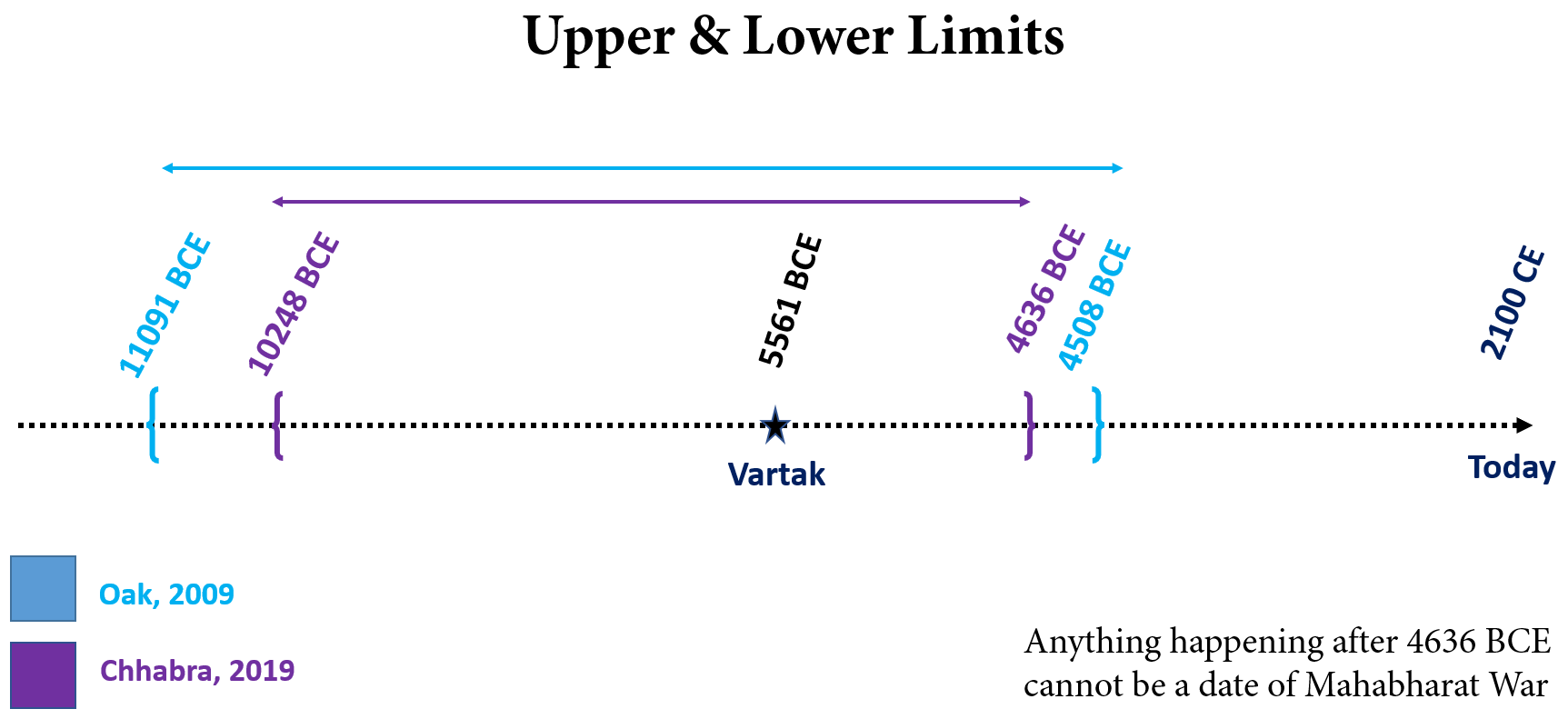
3.2.2 The First day and the lunar month of the Mahabharata War
The war descriptions through the 18 days of the war are rich in astronomy evidence. For example, there are 30+ references to phases and positions of the moon. First seven days of the war have no moon descriptions whatsoever and moon is described as ‘full moon’ or ‘full moonlike moon’ from 12 through 18th day of the War leading to the conjecture that the war indeed began on Amavasya and continued through the entire Shukla paksha of the lunar month. The descriptions of the evening and night immediately after the sunset are consistent with the war beginning on Amavasya. The full moon descriptions 12 through 18 days of the war are consistent with most of the war taking place during the Shukla paksha of the lunar month.
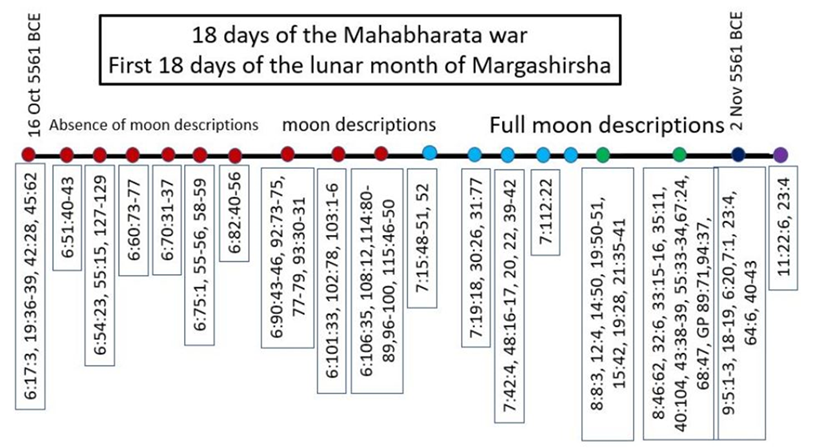
The specific positions of the moon near Krittika on the 12th day of the war and near Punarvasu on the 17th day of the war are consistent with war taking place during the Margashirsha Shukla paksha and during the first half of Sharad (pre-autumn) season.
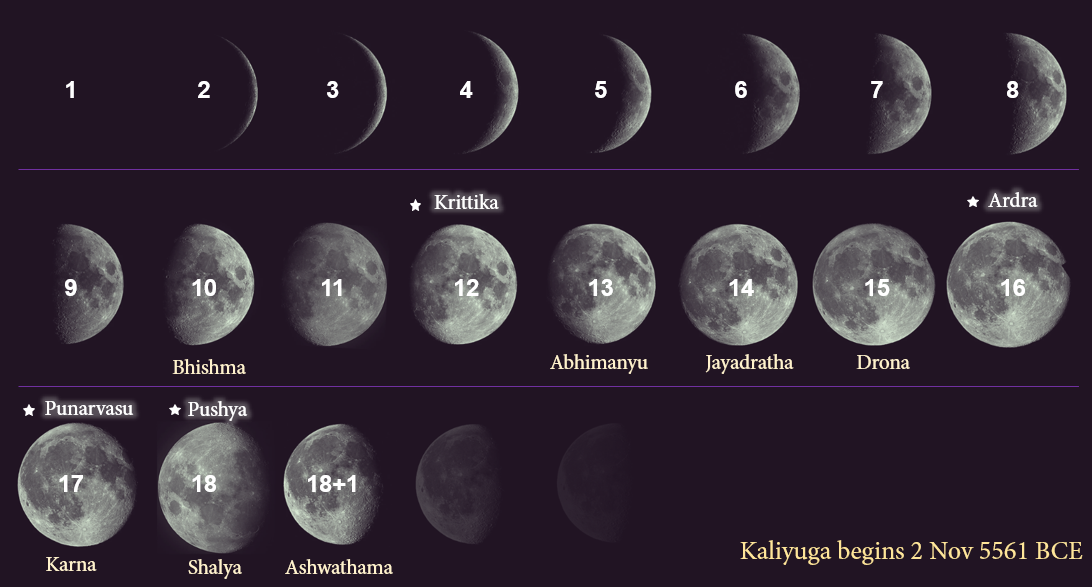
This conclusion is further reinforced by the fact that Kartika full moon had already occurred before the war and the fact that Bhishma Nirvana had occurred long before the Chaitra full moon.
3.2.3 Bhishma Nirvana
Bhishma Nirvana description had fallen prey to a baseless and illogical suggestion of Neelakantha Chaturdhar since 17th century. The decisive time interval (11091 BCE – 4508 BCE) led me to investigate Bhishma Nirvana evidence in meticulous details and what the Mahabharata text revealed was even more extraordinary than that revealed by AV evidence. Mahabharata text decisively showed that Bhishma was lying on the bed of arrows from the 10th day of the war until the day of Winter solstice for more than 92 days.
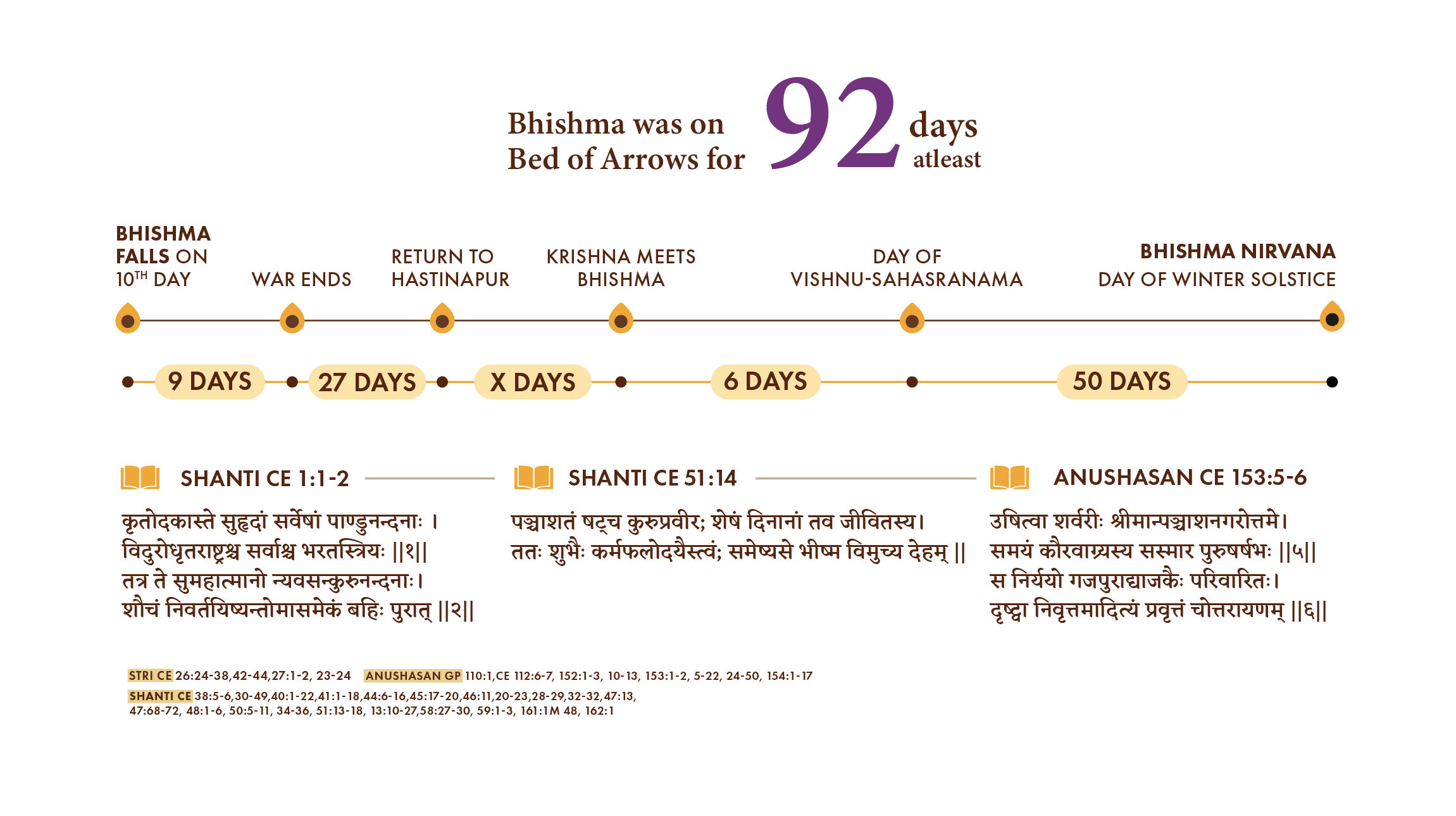
This chronology evidence proved that:
- The Mahabharata War took place during the first half of the Sharad season
- When this duration of Bhishma, on the bed of arrows is combined with the fact that the Mahabharata war took place during the first half of the lunar month of Margashirsha leads to the conclusion that a shift of about 4 lunar months has occurred with respect to seasons, i.e., While Margashirsha occurred during the first half of Sharad season during the Mahabharata war, now it occurs, shifted by 4 months, during the second half of Hemanta season.
- Thus, Bhishma Nirvana alone leads to the conclusion that the Mahabharata war occurred about ~8000 years ago, since shift of one lunar month with respect to the season occurs every 2160 years (4 x 2160 = 8640)
- Precise calculations and sensitivity analysis using YogaTara of specific Nakshatras and the speed of the precession of the Earth’s axis leads to a broad time interval of 7000 BCE through 4700 BCE and a refined time interval of 6722 BCE through 5125 BCE for the year of the Mahabharata War.
The biggest takeaway, based on the AV, Bhishma Nirvana and Moon phases/positions evidence is the decisive lower limit of 4500 BCE for the time of Mahabharata, i.e., Mahabharata war cannot occur anytime in the last 6500 years!
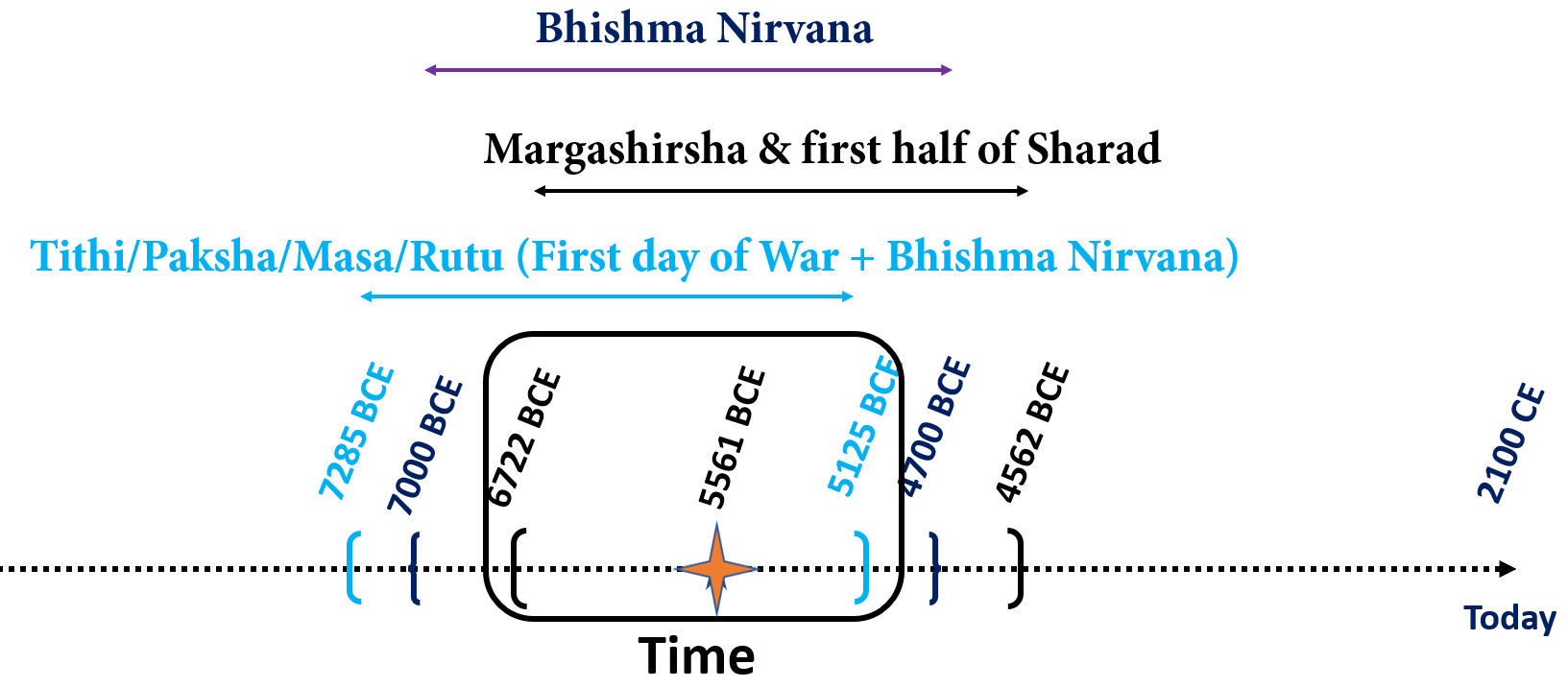
- 3 The Year of the Mahabharata War
The evidence of AV, Bhishma Nirvana and phases/positions of the moon narrowed down the valid time range for the year of Mahabharata war to an interval of 1600 years from 5100 BCE through 6700 BCE. There were a few claims for the year of Mahabharata war (5000 BCE, 5228 BCE, 5561 BCE) that fell within this interval. I began testing them with the assistance of additional Mahabharata evidence.
The Mahabharata text is super-rich in descriptions of the Graha (planets); their unique motions with respect to specific Nakshatras and conjunctions. This evidence not only leads to a specific and unique year of 5561 BCE as the year of the Mahabharata war, but also provides valuable insights into the sophisticated astronomy of Mahabharata times.
Below is a glimpse of the fascinating planetary evidence of the Mahabharata text and how it repeatedly and conclusively leads to 5561 BCE as the year of the Mahabharata war.
3.3.1 Oblique (Vakra) and Retrograde (Apasavya/Sthayi/Prawalit/Tishthati)
Mars – near Magha and near Jyestha/Anuradha
Jupiter – near Shravan (add 4 set of shloka)
Many Mahabharata researchers have interpreted ‘vakra’ to mean ‘retrograde’, however, no one has shown Mars going retrograde near Magha and again near Jyestha/Anuradha and Jupiter going retrograde near Shravan.
Anyone with basic knowledge of astronomy knows that Mars goes retrograde only once in about 2 years and it mean location for subsequent retrograde moves eastward by only about 2-3 nakshatras. This decisively falsifies interpretation of ‘vakra’ as retrograde during Mahabharata times. This is because there is a gap of 5+ nakshatras between Magha and Jyestha. Thus, other Mahabharata researchers not only failed to validate their conjecture but also unable to demonstrate their interpretation for their claimed year(s) of the Mahabharata war.
After detailed study of the various motions of all grahas and especially of Mars and Jupiter, I conjectured that Mahabharata author referred to oblique motion of Mars and Jupiter across the ecliptic as ‘Vakra’. When tested for the year 5561 BCE, Mars obliquely crossed the ecliptic from the south to the north and emerged to the north side near Magha. Mars obliquely crossed the ecliptic from the north to the south and emerged to the south near Jyestha/Anuradha. Jupiter obliquely crossed the ecliptic from the north to the south and emerged to the south near Sharvana. No other claimed year for the Mahabharata war can corroborate these three descriptions.
But we are not done! The things become very exciting. Many Mahabharata researchers have objected to my conjecture of ‘Vakri’= oblique crossing across the ecliptic, on the ground that in our times, Indian astrologers/astronomers refer to ‘retrograde’ motion as ‘vakri’. This is a poor argument because if the Mahabharata researchers truly believe what they are claiming to be true, all they have to do is show Mars retrograde near Magha and again near Jyestha/Anuradha and Jupiter retrograde near Sharavan for their claimed year of Mahabharata war. They are unable to do this and thus their objection is futile (Jati) and thus deserves rebuke. On the other hand, they ought to have asked me for my explanation of ‘retrograde’ in Mahabharata times since I assert that ‘vakra’ did not mean ‘retrograde’ during Mahabharata times. Afterall, ‘retrograde’ motions of planets are most fascinating, curious, and intriguing and Mahabharata author could not have missed them when difficult to notice ‘oblique crossing across the ecliptic’ are noted down.
Mahabharata author has indeed noticed and recorded retrograde motions for Saturn, Jupiter, Mars, and Venus. It is important to know the basics of ‘retrograde’ motions of planets to appreciate the meticulous, precise, and accurate retrograde descriptions of planets by the Mahabharata author.
Superior planets which are further from the sun than the earth and show a peculiar behavior during retrograde. Out of 3 superior planets that are visible to the naked eye, viz. Mars, Jupiter, and Saturn, while all of them become steady near a specific nakshatra space and become brighter, Mars becomes extremely bright during retrograde. Inferior planets, viz. Venus and Mercury are as such bright because of their vicinity to the Sun as seen from the earth. Venus and Mars create two distinct shapes: either like letter ‘Z’ or ‘elongated circle’ in the sky during their retrograde motions. All planets become steady in one place (Sthayi, Dhruvam, Tishthati) in the sky during retrograde.
The Mahabharata text describes Saturn and Jupiter appearing ‘bright’ while becoming steady for a long period (up to a year) in the vicinity of Vishakha. Saturn is also described near Bhaga (Uttara Phalguni) while Jupiter is described as crossing the ecliptic obliquely near Sharvana. These descriptions fix the position of Saturn near Uttara Phalguni and that of Jupiter near Sharavan. This is only valid in 5561 BCE.
The retrograde motions of Mars and Venus around 5561 BCE provide the decisive and conclusive evidence. Mars can be shown to have gone retrograde near Chitra and Swati while Venus can be shown to have gone retrograde near Purva Bhadrapada.
The remaining 20+ planetary descriptions validate and corroborate 5561 BCE as the year of the Mahabharata war. They are described below.
3.3.2 Akramya + Tishthati
Saturn, a nonspecific planet (Shyam graha), a comet, and another non-specific planet (Shyam graha) have been described near (akramya) nakshatra bhaga (phalguni), near Chitra, near Pushya and near Jyestha, respectively. A non-specific planet (Shweta graha), a comet and another non-specific planet (Shyam graha) have been described as ‘Tishthati’ near nakshatra Chitra, Pushya and Jyestha, respectively. These descriptions are shown to be consistent with positions of Saturn, Halley’s comet, and Jupiter for the year 5561 BCE. No other year, other than 5561 BCE can validate ‘akramya’ and ‘tishthati’ descriptions at designated nakshatra positions.
3.3.3 Peeda to Rohini
Saturn is described as giving ‘peeda’ (affliction) to nakshatra Rohini. Combination of Sun and Moon are described as giving ‘peeda’ to nakshatra. A more interesting observation is that of Jupiter that is described as doing the same (similar to Sun/Moon), i.e., giving ‘peeda’ to nakshatra Rohini, yet specifically after the sunset on the 17th day of the war. This comparison between Jupiter and Sun/Moon turned out to be the key in comprehending ‘peeda’ descriptions. Sun and Moon were together (Amavasya) on the first day of the war and could be visualized as giving ‘peeda’ to nakshatra Rohini which was rising on the eastern horizon at the time of the sunset. Fast forward to 17th day of the war and the same scenario was repeated where Jupiter was giving ‘peeda’ to rising Rohini, after sunset. Saturn could be shown to be giving ‘peeda’ to nakshatra Rohini, from its position near nakshatra U Phalguni in a fashion consistent with ‘peeda’ given by either Jupiter or Sun/Moon duo. This is validated only for the year 5561 BCE.
3.3.4 Seven Graha and Sun or Moon
Everyone likes to see empirical evidence in support of a claim. This is based on our desire to see the evidence via ‘pratyaksha’, sense perception. Unfortunately, most of us are not trained scientifically, logically, and contextually to comprehend and appreciate empirical evidence when one is presented.
Mahabharata presents 3 instances of 7 grahas were seen 1. Near the Sun before the war, 2. Attacking the Moon on the 14th day of the war and 3. Going away from the sun on the 16th day of the war. All 3 cases are that of visual observations and thus the nodes of the Moon (Rahu) are out of scope. All 3 cases involve 7 planets exclusive of either the Sun or the Moon. This leaves us with 5 planets visible to the naked eye. In the year 5561 BCE, these 3 instances are corroborated when one considers the positions of Uranaus, Neptune and Pluto. No other Mahabharata researcher and no other Mahabharata date corroborates these 3 descriptions.
3.3.5 Conjunctions of Graha
Mahabharata text mentions numerous conjunctions of graha and these descriptions are corroborated for the year 5561 BCE. On the other hand, no other claimed year of the Mahabharata war succeeds in corroborating these descriptions. There are many conjunction descriptions however for brevity two of them are presented. Venus, Mars, and Mercury are described together in the sky on the 18th day of the war and Saturn and Moon are described together in the sky on the 18th night of the war. These descriptions are corroborated for the year 5561 BCE and only for the year 5561 BCE.
There is much additional planetary evidence, however, it is not covered for the sake brevity. This includes solar and lunar eclipses, specific risings of the Moon through the 18 days of the war and numerous planetary conjunctions. All of them are validated for 5561 BCE.
- 4 Oceanography evidence for flooding and destruction of Dwarka in 5525 BCE
The oceanography evidence is impressive. It is enormous and precise. Mahabharata tells us that Krishna’s Dwarka was flooded and destroyed by gushing seawaters, and this occurred 36 years after the Mahabharata war. This leads us to (5561 BCE + 36 = 5525 BCE) as the year for the flooding and destruction of Dwarka. Let’s look at the enormous and impressive, precise, and accurate evidence from around the world. We will begin with Dwarka itself.
3.4. 1Dwarka evidence
A significant sea level rise of about 15 meters occurred in the Arabian sea at the middle of the 6th millennium BCE (5525 BCE). This flooded and destroyed Krishna’s Dwarka. The water levels continued to rise for the next few centuries and went up further by additional 8 meters resulting in water levels higher by about 3 meters than sea levels today. This higher sea levels stayed that way for the next~3000+ years and explain why Dholavira or Lothal could operate as seaport locations during 4000 BCE through 2000 BCE).
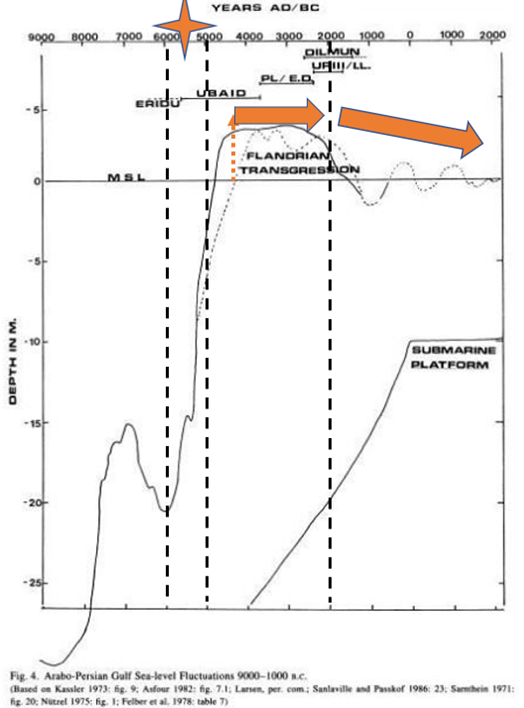
Dwarka ocean level rise
The causes for this sudden and significant sea level rise are complex and beyond the purview of this paper, however, the evidence of this sudden sea level rise is observed around the world.
3.4.2 Sea ingression on the east coast of India (Poompuhar)
While Arabian sea experienced 20+ meters of sudden sea level rise in 5525 BCE, the sea water ingress in the Bay of Bengal was as deep as 20+ Kilometers inland from the current seashore, all the way to the town of Mayuram (Mayladuthurai) on the east coast of Tamilnadu. Mayuram served as seaport for the next 2000s+ years before seawater started receding and reached the current location (Poompuhar) by 500 BCE.
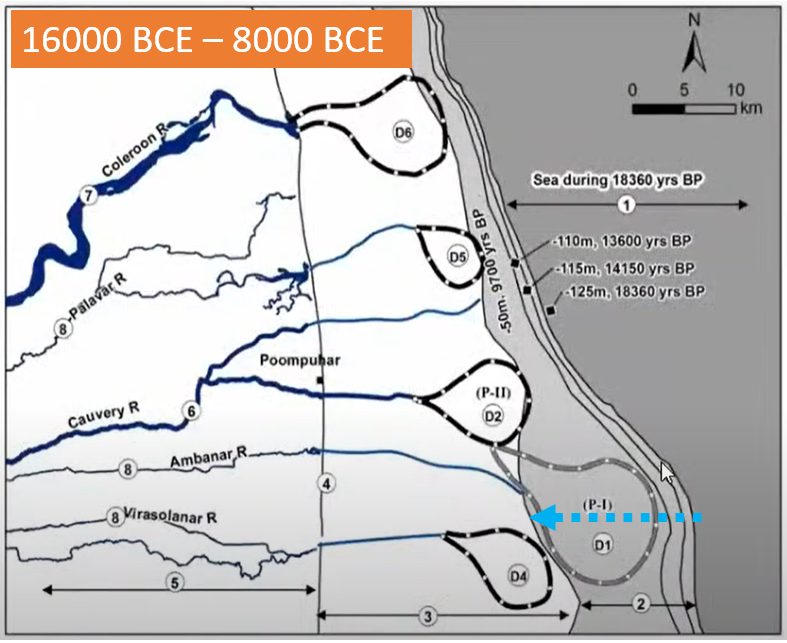
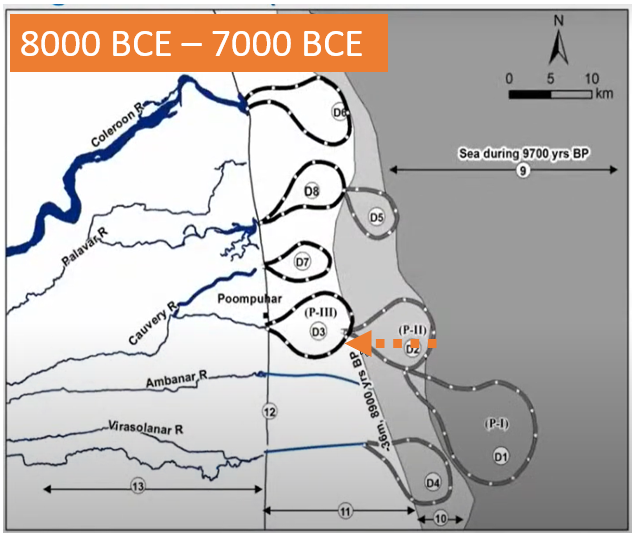
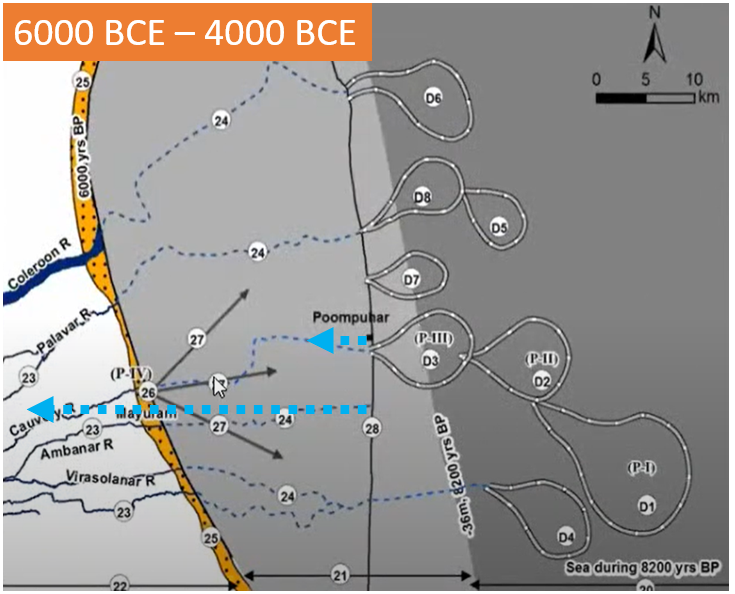
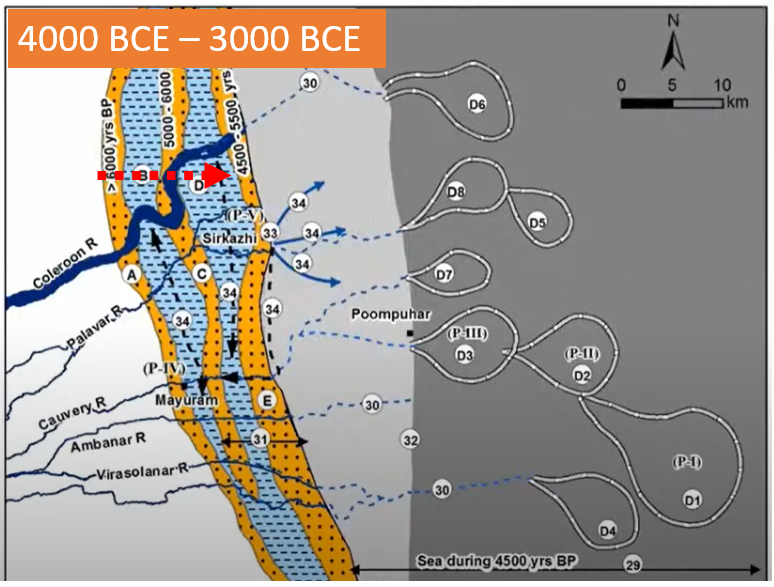
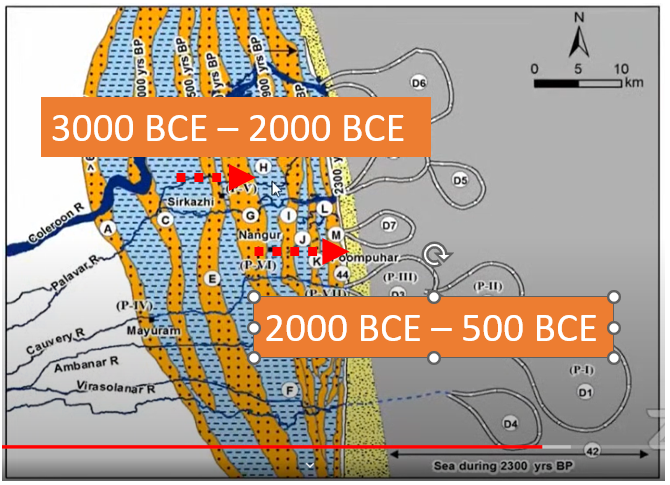
18000 years of sea level fluctuations
3.4.3 Cave records of Sea level rise of the last 7500+ years
This evidence is beyond mysterious, marvelous and an outcome of one lucky coincidence. A cave in the northwestern tip of Sumatra, Indonesia, not far from India’s Andaman and Nicobar Islands has preserved an impressive records of seal level rise, beginning with the time of Dwarka flooding in 5525 BCE, down to our times including the disastrous Tsunami of 2004. This data corroborates worldwide evidence of sea level rise in 5525 BCE. The most fascinating aspect of this evidence is the decisive falsification it provides for any claim for sea level rise between 3500 BCE and 1500 BCE. This is significant as many Mahabharata researchers have claimed the date of Mahabharata war in this time interval. In fact, the data is so decisive, these same Mahabharata researchers have changed their positions about the nature of flooding at Dwarka and are now claiming flooding of Dwarka as a ‘local’ trivial event!
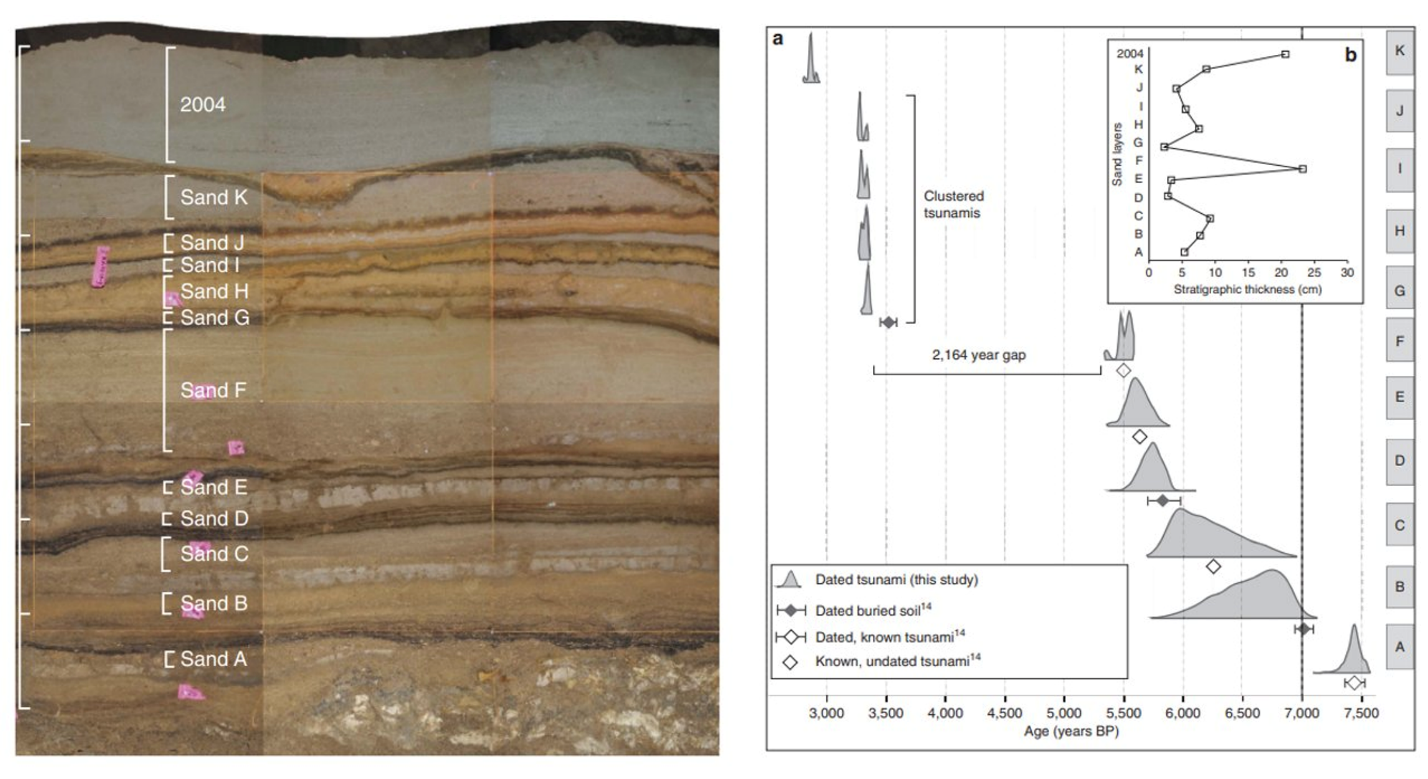
7500+ years of sea level rise showing no rise 3500 BCE through 1500 BCE
3.4.4 Instantaneous formation of Black Sea
This global and sudden sea level rise led to the water of Atlantic Ocean gushing into the Mediterranean Sea which in turn increased the water levels of Aegean Sea/Sea of Marmara and the water broke through what is now known as Bosphorus channel pouring water to the north into what a small lake transforming it into today Black Sea. The instantaneous nature of this event occurring at the time coinciding with flooding and destruction of Krishna’s Dwarka has been demonstrated via nine different empirical parameters by Columbia University geologists.
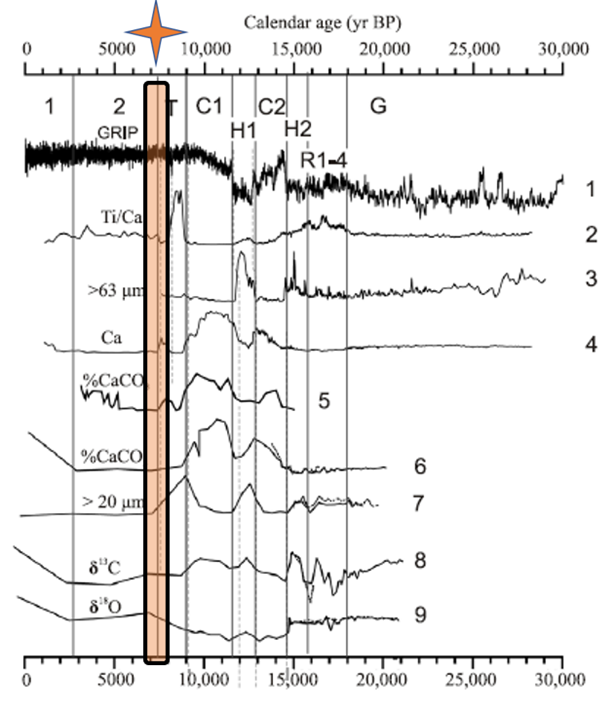
Sudden formation of Black Sea based on 9 scientific parameters in 5525 BCE
3.4.5 Sudden Sea level rise in the West Indies
Even places as far away as the West Indies were not spared by this sudden sea level rise. Paul Blanchon and John Shaw from the University of Alberta in Canada where I did my MS in Chemical Engineering have provided impressive evidence of sea level rise as high as 6.5 meters +/- 2.5 meters at seven different locations in the West Indies coinciding with the timing of flooding and destruction of Dwarka in 5525 BCE.
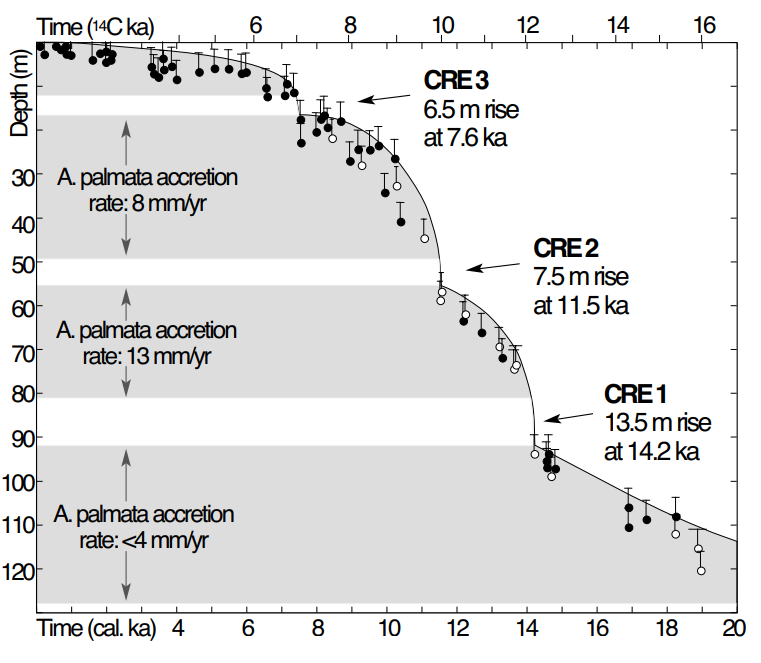
6.6 meters +/-2 Meters sudden rise at 7 locations in 5525 BCE
3.4.6 More evidence and conclusion
Enormous additional evidence exists for sudden sea level rise around 5525 BCE around the world and it is not described in detail for brevity’s sake. Some of the key locations are mentioned in the world map below.
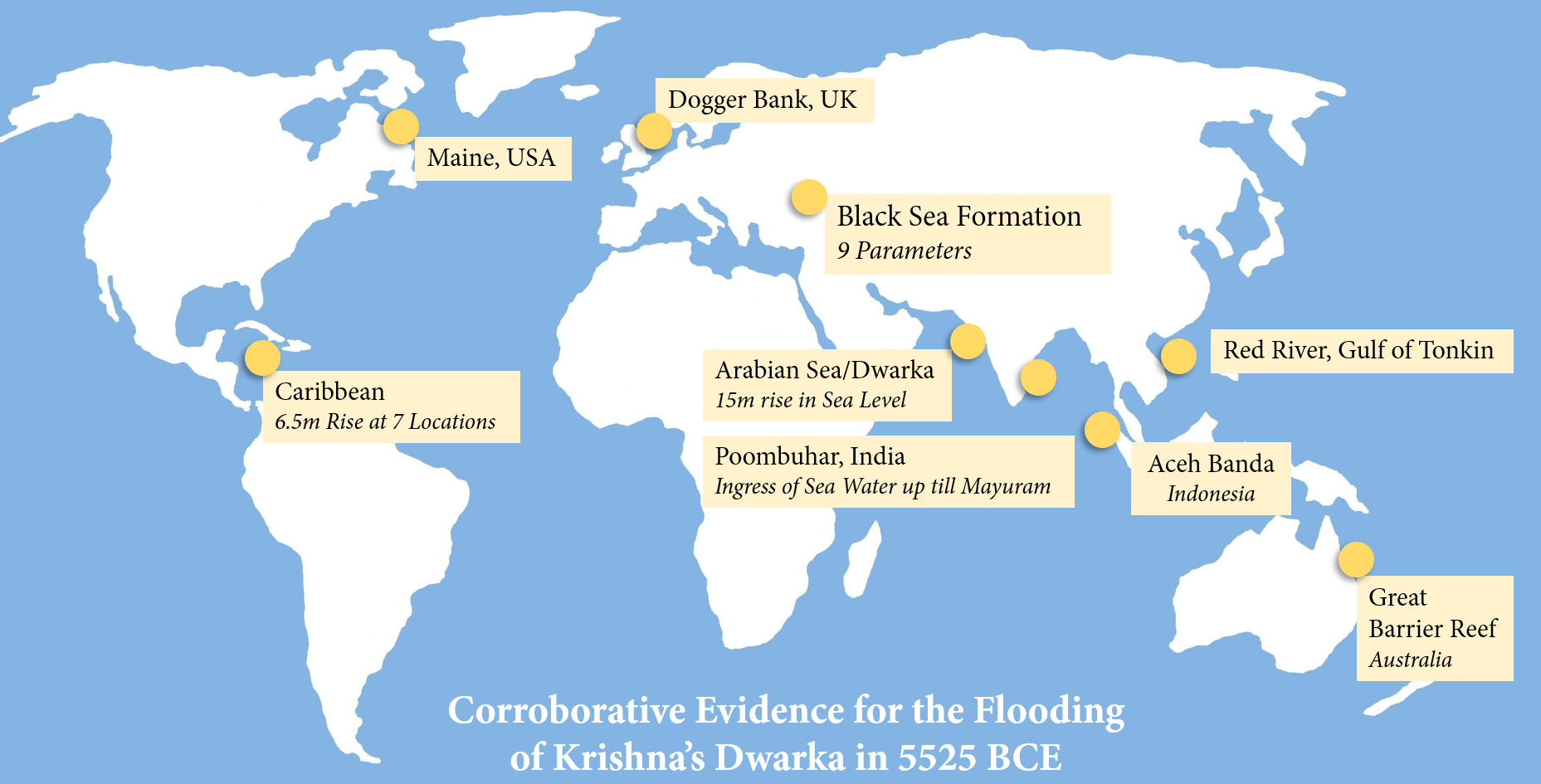
- Archaeo-genetics evidence for the Mahabharata War
Physical anthropology evidence, provided by research team of Prof. K. A. R. Kennedy from Cornell University, in the form of craniometric and cranial non-metric data points to biological discontinuity for the Northwest India between 6000 BCE and 4500 BCE which corroborates well with the Mahabharata war of 5561 BCE. Four years after my publication of the book ‘When did the Mahabharata War happen? The Mystery of Arundhati’, an exciting genetics research paper by Monika Karmin was published in 2015 looking at the global genetics data inferring a strong bottleneck in male (Y-chromosome) lineage. This piqued my curiosity. What I found was beyond fascinating.
3.5.1 Who participated and from where
The Mahabharata descriptions of geography tells us that the warriors came from as far as modern Iraq/Turkey in the west, as far north as Kyrgyzstan in the north, and as far as Vietnam/Indonesia in the east. Total of 18 akshauhini male warriors fought for the 18 days and almost all of them died during the war. This number is estimated to be about 4 million warriors.
3.5.2 The context (place, time, and circumstances)
Modern estimates for the total human population of the world during the 6th millennium BCE (5561 BCE) range from 5 to 20 million. Let’s assume half of this population (10 million) belonged to the area that corresponds to the warriors who participated in the Mahabharata war. This leads to male population of 5 million assuming 50:50 gender ratio.
Recall that Mahabharata estimates the male population died within the 18 days of the war equal to 4 million. This leads to the estimate of 1 million surviving male population which in turn leads to the surviving Female: Male population ratio of 5:1.
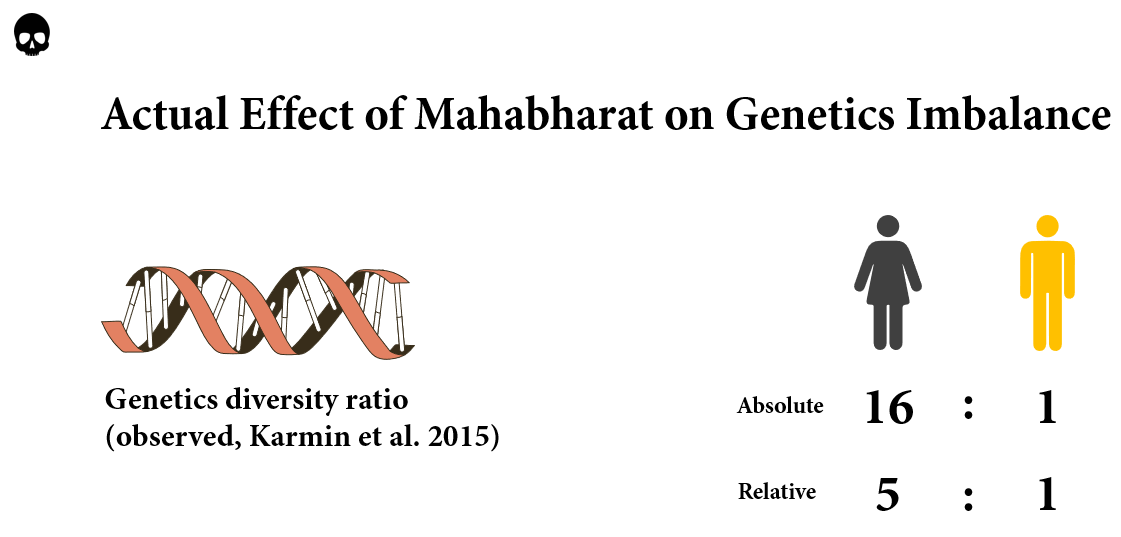
What Karmin et al research tells us is that there was a bottleneck in male (Y-chromosome) and the peak of this bottleneck can be noticed around 5500 BCE and that the epicenter (the first area to experience it, have the deepest impact and the last one to recover) was India. The magnitude of this imbalance, i.e., Female/Male ratio saw the maximum of 16:1 if measured on the absolute scale. It is important to note that in normal times, the Female:Male distribution is imbalanced at 3:1. This is logical if we understand that every female-male encounter bring together 3 X-chromosomes and 1 Y-chromosome as Female (X1X2) and Male (X3Y1). Therefore, if Female:Male imbalance ratio is measured on a relative scale, i.e., 16/3 gives us the number that matches with our estimate of 5:1, post Mahabharata Female: Male ratio.
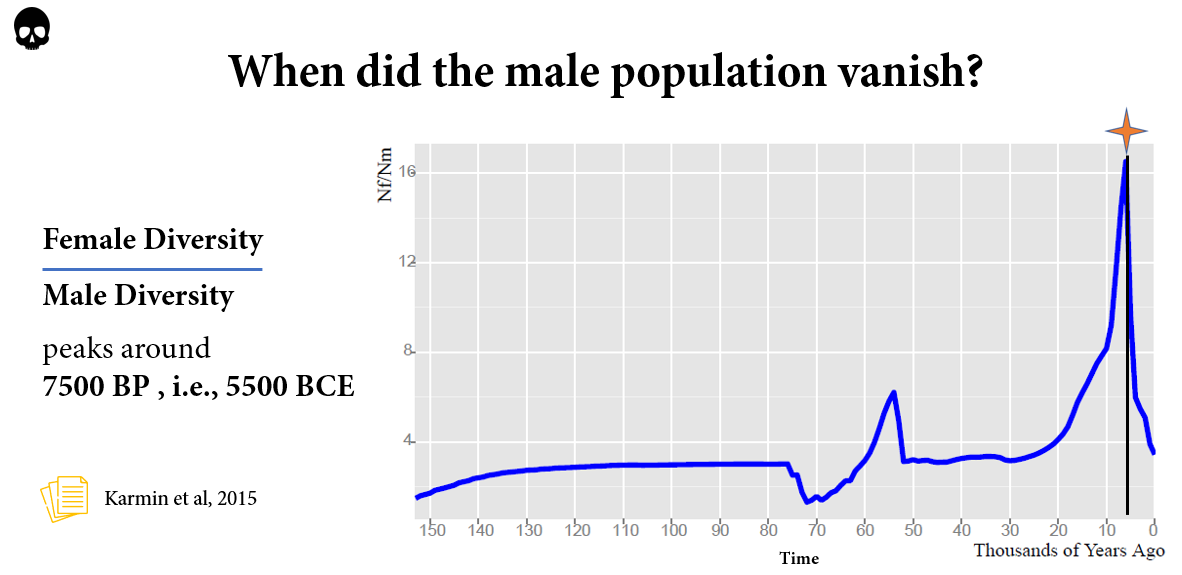
If you have had no goosebumps at this point, you have not understood the fascinating genetic evidence, staring in your face that not only validates 5561 BCE as the year of Mahabharata war but also provides additional validation for non-dating (geography, population, measurements) descriptions in the Mahabharata text. There are many other fascinating insights in this paper that further validates additional aspects of the antiquity of Indian civilization, however, I will refrain the temptation to explain them, here. This is because there is one more equally fascinating area of this Itihasa that must be covered.
- Scientific Biography of Krishna (5633 BCE – 5525 BCE)
Mahabharata text tells us that Bhagavan Krishna ended his earthly existence at the same time with flooding and destruction of Dwarka, i.e., in 5525 BCE. Unfortunately, Mahabharata text does not provide useful and scientifically testable information that would be useful for us to estimate the birth year of Bhagavan Krishna. Fortunately, one critical piece of information was provided by Bhagavata Purana, and Harivamsha (Khila Parva of Mahabharata) provided unique set of conditions to determine the birth year of Bhagavan Krishna.
- Bhagavata Purana
Bhagavata Purana (3:2:26) tells us that Krishna was 11 years old when he killed Kamsa. This ordinary sounding information turned out to be extremely crucial in determining the lifetime of Bhagavan Krishna.

3.6.2 Harivamsha
Harivamsha documents amazing evidence of comet, in apparition, covering the entire visible sky beginning with Nakshatra Bharani, at the time of the Kamasa-vadha. Additional astronomy descriptions also exist and all of them point to the year 5622 BCE. The description of comet is crisp, precise and by itself and in combination with additional astronomy descriptions allows us to assert that no such instance can be shown to have occurred at any other time in the last 7500 years.
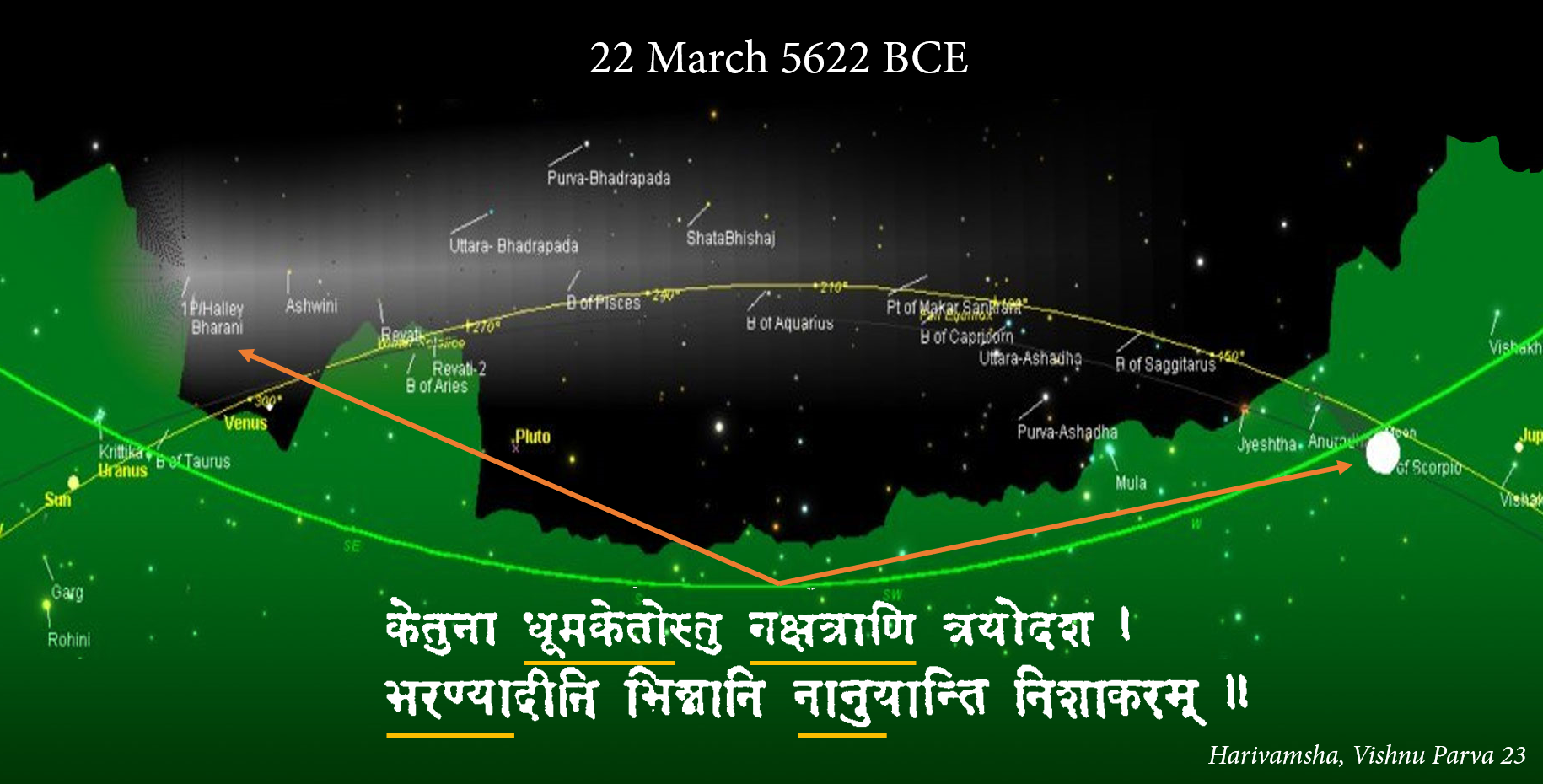
Krishna was 11 years old when he killed Kamsa (5622 BCE) and thus Krishna was born in 5633 BCE. Harivamsha also provides terrestrial and seasonal descriptions at the time of Krishna’s birth, and they match well for 5633 BCE. This means Krishna lived for about 107/108 years (5633 BCE – 5525 BCE). Various ancient Indian narratives state his age to be greater than 100 years, however Shri Madhavyacharya (Ananda Tirtha) the founder of Dvaita school of Vedanta calculated it to be precisely equal to 107 years, in his Mahabharata Tatparya Nirnaya.
While I determined Krishna’s Mahanirvana based on Mahabharata evidence (5561 BCE and 5525 BCE), Krishna’s birth year was determined based on Bhagvata Purana and Harivamsha evidence (5622 BCE and 5633 BCE). His total lifespan on 107, so arrived, is confirmed by the statement of Sri Madhavacharya. This is a wonderful illustration of validation of Itihasa Kalanirnaya via Shastra-pratiti, Guru Pratiti and Atma-Pratiti.

Sri Mahabharata TatparyaNirnaya 32:8-9
- How to explain multiple claims ranging from 7300 BCE through 400 CE
A brief note is to explain what led 130+ Mahabharata researchers to arrive at those many different dates for the year of the Mahabharata war.
All researchers except for ‘yours truly’ did not start with a ‘unsolved toughest problem’ of Mahabharata, one not solved by previous researchers of their times. All researchers, except for ‘yours truly’ did not employ Mahabharata text as their primary text and did not include all relevant evidence of the Mahabharata text. All of them except ‘yours truly’ did not and could not formulate even the basic statement of their theory. Majority of them had a priori year in their mind and their efforts were focused on justifying that claim rather than critically testing and analyzing it scientifically and logically.
Lastly, a successful theory while solves the toughest unsolved problem, not solved by others, it also leads to newer problems of higher complexity and of higher importance. It also leads to growth of knowledge by solving many other puzzles not considered at the time of its proposition. All these things have happened with my theory and its evidence-based testing. In fact, it has provided the foundation for exploration of 75000+ years of ancient Indian civilizational development via multiple disciplines of science.
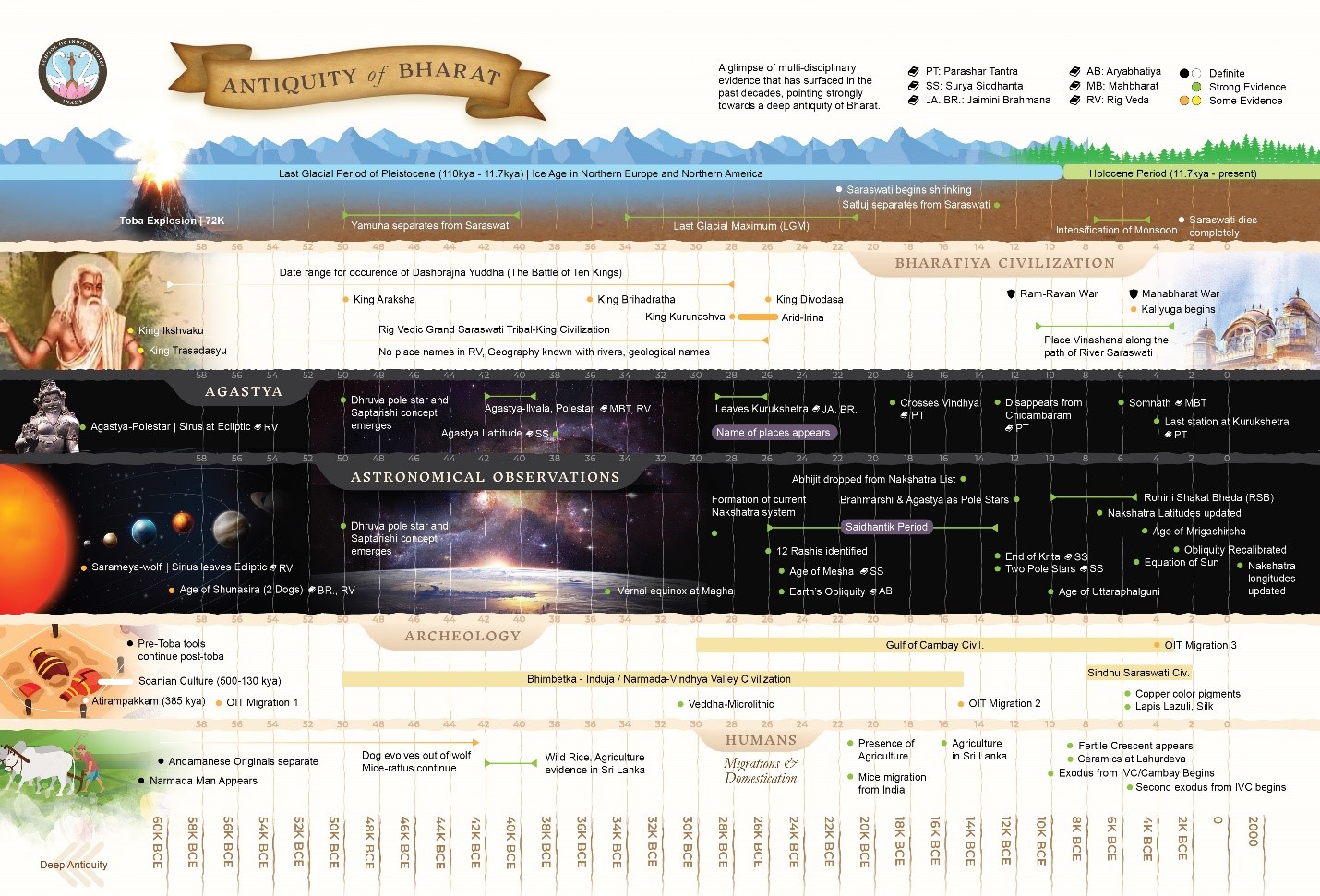
Selected Bibliography
- The Mahabharata (CE). BORI critical edition. Bhandarkar Oriental Research Institute, Pune.
- The Mahabharata (GP) – Gita press edition with Sanskrit text and Hindi translation. Gita Press, Gorakhpur, India.
- The Mahabharata (SR) – Southern recension (1934), critically edited by P S Sastri. V Ramaswamy Sastrulu & Sons. Madras, India.
- Oak, Nilesh (2011) When did the Mahabharata war happen? : The Mystery of Arundhati. Danphe Inc., USA.
- Oak, Nilesh (2018) Bhishma Nirvana: Astornomy Poison Pills, Bhima LLC, USA
- Popper, Karl (2002) Conjectures and Refutations, Routledge, London, UK.
- Popper, Karl (2002) The Logic of Scientific Discovery, Routledge, London, UK.
- Rigveda Samhita, Gita Press, Gorakhapur, U.P. India.
- Sarkar et al (2016) Oxygen isotope in archaeological bioapatites from India: Implications to climate change and decline of Bronze Age Harappan civilization, Scientific Reports, 6:26555, DOI: 10:1038/srep26555
- Singh et al (2017) Counter-intuitive influence of Himalayan river morphodynamics on Indus Civilisation urban settlements, Nature Communications, 8:1617, DOI: 10.1038/s41467-017-01643-9
- Talageri, Shrikant (2000) The Rigveda – A Historical Analysis, Aditya Prakashan, New Delhi, India
- https://youtu.be/apicwV1tPiY
- https://youtu.be/ZjiC5B3RdLY
- https://youtu.be/sGrfRWcRziY
- https://youtu.be/cUKFJoBAvoc
- https://youtu.be/8GJRN33HsNU
- https://youtu.be/MvVP7_uMzA0
- https://youtu.be/gowjfVf_7mM
- https://youtu.be/BbcAkz_LZ5s
- https://youtu.be/e2-WEjWlhrg
Image source: Wikipedia



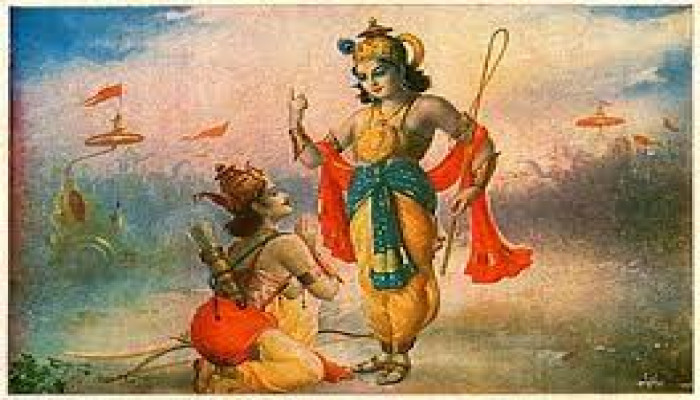



Comments